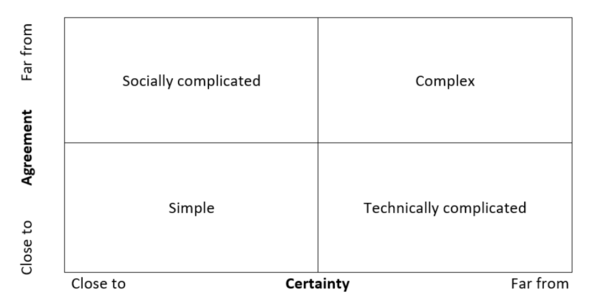The situational complexity framework was proposed by Stacey (1996) using the Agreement & Certainty Matrix shown below.
 Adapted from Zimmerman (2001); found in Patton (2011).
Adapted from Zimmerman (2001); found in Patton (2011).
The framework uses two axes:
- The level of certainty about cause and effect to solve a problem
- The level of agreement among stakeholders about the desirability of the solution
More recently, Zimmerman (2001) and Patton (2011) applied this framework to program evaluation (Chazdon & Grant, 2019). In that context, the term situational complexity refers specifically to the distinction between simple, technically complicated, socially complicated, and complex situations. This distinction is attributed to the work of organizational theorists Ralph Stacey (1996) and David Snowden (2002).
Situational Complexity in the context of Dialogic Design Science
In the context of Dialogic Design Science, we ground our definitions of situational complexity in the three phases of science.
Objective Situational Complexity
This type of complexity is observer-independent. It is the kind of complexity that exists in 1st phase of science, which assumes the construction of high-quality observations (i.e., measurements) can be fully separated from the actions that could be taken to improve the situation. The phenomenon of gravity presents a great example. Different observers can make measurements of falling objects and try to estimate g. The result is always the same, i.e., it is independent of the observers.
Subjective Situational Complexity
Intersubjective Situational Complexity
References
- Chazdon, S., & Grant, S. (2019). Situational Complexity and the Perception of Credible Evidence. Journal of Human Sciences and Extension, 7(2), 4.
- Patton, M. Q. (2011). Developmental evaluation: Applying complexity concepts to enhance
innovation and use. New York, NY: Guilford Press.
- Snowden, D. (2002). Complex acts of knowing: Paradox and descriptive self-awareness. Journal
- Stacey, R. D. (1996). Complexity and creativity in organizations. San Francisco, CA: Berrett-
Koehler Publishers.
- Zimmerman, B.,(2001). Ralph Stacey's Agreement & Certainty Matrix, Schulich School of Business,
York University, Toronto, Canada. Online at: https://www.betterevaluation.org/en/resources/guide/ralph_staceys_agreement_and_certainty_matrix